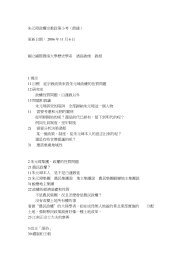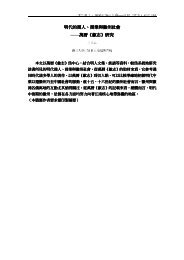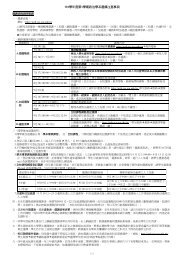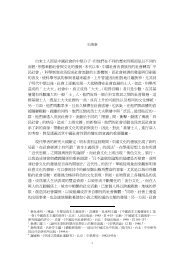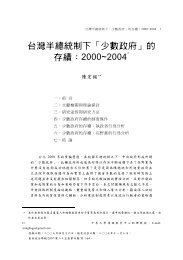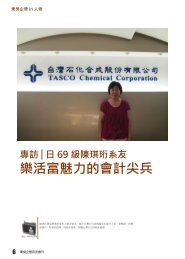總統國會制的一致政府與憲政運作: 以馬英九總統第一任 ... - 東吳大學
總統國會制的一致政府與憲政運作: 以馬英九總統第一任 ... - 東吳大學
總統國會制的一致政府與憲政運作: 以馬英九總統第一任 ... - 東吳大學
You also want an ePaper? Increase the reach of your titles
YUMPU automatically turns print PDFs into web optimized ePapers that Google loves.
總 統 國 會 制 的 一 致 政 府 與 憲 政 運 作 : 以 馬 英 九 總 統 第 一 任 任 期 為 例 175<br />
Unified Government and Constitutional<br />
Operation in President-Parliamentarism<br />
During the First Term of President Ma,<br />
Ying-jeou in Taiwan<br />
Tsai, Jung-Hsiang *<br />
Chen, Hong-Ming <br />
Conventional wisdom on semi-presidentialism has claimed<br />
that unified governments can entail more political stability and<br />
less political deadlock than minority governments. However,<br />
when we observe the operation of unified governments in<br />
Taiwan’s semi-presidential trajectory from 2008 to 2012, we can<br />
identify political cleavages within the executive and political<br />
conflicts between the executive and legislative branches. Why do<br />
unified governments in president-parliamentarism still suffer<br />
serious political cleavages within the governing party Our findings<br />
are below. First, Taiwan’s parliament passed some controversial<br />
bills to rebel against the president’s authority or preeminence over<br />
the parliament. Second, the enlargement of presidential real<br />
authority or power has curtailed the autonomy of the premier and<br />
cultivated non-collectivization of the cabinet. Third, the<br />
phenomenon of presidentialization has weakened the functions of<br />
the ruling party. Fourth, Taiwan as a president-parliamentary<br />
system, one subtype of semi-presidentialism, did not experience<br />
* Associate Professor of Political Science, National Chung Cheng University.<br />
Associate Professor, Center for General Education, Chung Yuan University.




